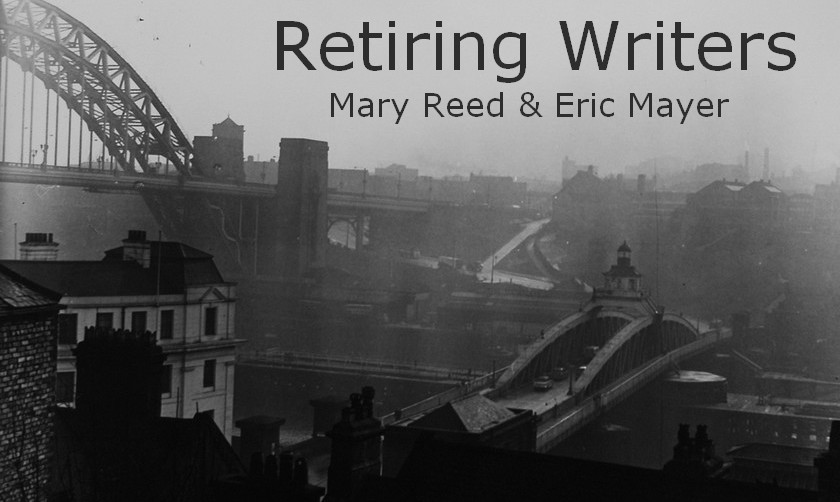The first thing the horrified technician said was "You were lucky not to have had an explosion."
Since last we darkened subscribers' in-boxes, some days at Maywrite Towers have been less dances of delight than Fortuna deciding to play the cat and banjo with our plans.*
A couple of examples. The ongoing Rebellion of Household Machinery struck last month when an out of season cold night triggered the heating. The boiler leapt into life, hummed through its cycle, and shut down.
Unfortunately there was no heat.
Soon afterwards, the water heater attempted to balance out our lack of warmth by producing hot water that was far too hot, diagnosed as caused by our water's high mineral content reaching the point when it blocked the relief valve, leading to the technician's remark mentioned above. All this, mark you, despite annual inspections of both appliances. And what, you ask, about the problem with the boiler? Well, it turned out its thermocouple had conked out only a couple of years after its last replacement.
We are of course grateful the boiler didn't wait to work its ticket in the frigid months soon to advance down the pike, as it did one memorable night a few years back when the thermostat failed during the dark hours and we woke up to a house temperature in the forties.
Speaking of cold weather reminds me country folk say when mice migrate into a house during autumn it's a certain sign of a harsh winter ahead.
Living as we do on the very edge of woodland, occasional visits from wildlife are inevitable. As a result animals paying a call have included deer dining on our day lilies and a flock of wild turkeys tearing up our back lawn -- though to be fair they left the front one alone. Smaller fry of various descriptions have also occasionally found their way indoors. A while back a creature about as long as my thumb was caught stealing the cat's dry chow if you please. We had already deduced something was afoot because a small cache of said comestibles was found in one of Eric's sneakers. Given this particular visitor's fur was dark, it appeared to be eyeless, and moved so smoothly it might as well have been on roller skates, my guess would be it was a pygmy shrew but I can't be certain, because I observed it as it was moving fast away from me and in poor light to boot. Whatever it was, it was never seen again.
Then there was the unfortunate mouse with a broken leg, likely caused by our then resident feline Sabrina. However, there are doubts as to her guilt because when the mouse appeared he and she crouched a few feet apart, staring at each other. Sabrina took no interest whatsoever. If only we had a camera...that mouse was a fine example of what we might call a Disney mouse. Despite lack of white gloves, red shorts, or large yellow paw-wear, he was a neatly turned-out little fellow with grey fur and a white pinny undercarriage. But he also possessed exceedingly long teeth as sharp as needles, as we saw when he was escorted from the premises to be released into the woods out back.
Lugubrious British comedian Les Dawson once claimed he knew when his mother-in-law was coming to stay because their mice threw themselves on the traps. We have never seen one of the newfangled "rodent exterminators" (otherwise known as electric mousetraps) though we understand they do exist, nor are we keen on spring-loaded or sticky traps. Yet you cannot entertain mice in your living space -- think of them as house fleas. At least they were not as destructive as Beatrix Potter's Two Bad Mice. On the other hand, I'd say it's acceptable to give a pass to sugar mice, Cinderella's mice-horses, and the somnolent dormouse at the Mad Hatter's tea party, who were all better behaved.
What puzzles us is why they insist on intruding because we always make certain food is stored in covered containers or in the fridge overnight. Now Sabrina has crossed over the rainbow bridge there's not so much as a bowl of cat chow to raid.
Despite all precautions, however, last month we received several visits from field mice. It was as if a murine entrepreneur was running a charabanc to save them having to walk to our house. The Pied Piper of Hamlin being elsewhere engaged, we dealt with their invasion by reluctantly laying down poison and then transporting the departed into the woods for disposal, with a pickle jar retrieved from the bag of recyclables serving as their hearse.
Apparently it isn't just us: the technician who restored our heating boiler to working order mentioned his house was under siege as well.
* Tips of the hat to Phil Ochs and Rudyard Kipling respectively.
